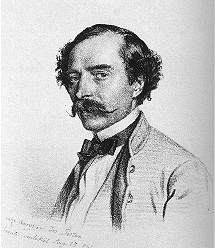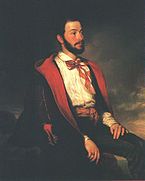
József Borsos
Encyclopedia

Realism (visual arts)
Realism in the visual arts is a style that depicts the actuality of what the eyes can see. The term is used in different senses in art history; it may mean the same as illusionism, the representation of subjects with visual mimesis or verisimilitude, or may mean an emphasis on the actuality of...
.
Biography
He finished his studies in ViennaVienna
Vienna is the capital and largest city of the Republic of Austria and one of the nine states of Austria. Vienna is Austria's primary city, with a population of about 1.723 million , and is by far the largest city in Austria, as well as its cultural, economic, and political centre...
where he garnered much attention. His portraits of distinguished contemporaries and his elaborate genre pictures were highly successful, e.g. Portrait of Kristóf Hegedűs
Portrait of Kristóf Hegedus
The Portrait of Kristóf Hegedűs is an 1844 painting by Hungarian painter Jozsef Borsos. It was one of his earliest works.The oil on canvas measures 126.5 x 82 cm and is currently on display at the Historical Picture Gallery section of the Hungarian National Museum, Budapest-Sources:*...
(1844) "Wine, Woman, Love" (1847), and "Girls after the Ball" (1850). His typically biedermeier colours, realistic, strong and delicate, and his harmonic compositions made him popular with the public patronizing art in Pest. After losing his money on the Stock Exchange, he moved from Vienna to Pest in 1861. Unable to compete with fotography, he opened a photographic studio and died as the owner of the restaurant "Szép Juhászné". His works: "Alms", "Sunset", "The Letter", "Grapes or a Kiss", "National Guard", "Bathing Women", "The Portrait of Zitterbach, an Architect", "The Portrait of Ferenc Pulszky", and "Pigeon Post".


